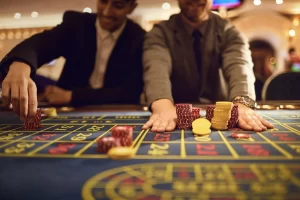How Casino Classics Are Evolving in Digital Spaces

With digital casino gaming, players are able to exploit all the mechanics and strategies associated with classic casino games in the easiest way possible: they can indulge in playing it whenever they want!
Whether it’s your thing or not, there’s something here to cater to your every whim, from the thrill of heist flicks to titillating trump stacks and, of course, cheeky Texas Hold ’Em fancies. As technology has adjusted to our whims, it has grown to become a deft comrade, ranging from ewallets to phones, a thoroughly alluring companion that gamers and high rollers can enjoy together, made all the more thrilling and crafted by skilled cinematographers from filmmakers to industry insiders. We play and pay for entertainment, and with enough imagination, math and lasers involved, we can have a blast while doing it.
Slot machines
Slot machines, once an embarrassment at casinos – small jackpots and payback percentages that dwarfed the ones given at blackjack or craps tables – now attract the highest percentage of gamblers. Slot-machine players get no comps – free rooms, shows and meals – the way table gamers do. Today, that has all changed.
The development and emergence of online gaming have made it easier for people to enjoy their time in a casino via online platforms. People are able to feel literally sucked into casino gaming activities in massively multiplayer online role-playing games (MMORPGs), survival games and board or card games. This is so because casino games can now be found in electronic forms with seemingly infinite variations.
Meanwhile, the video-slots market itself has adapted by making slot games prettier and more pop-culture-themed, adding gimmicks such as touchscreens and group competition from video gaming, and hosting quick-fire tournaments that players can enter whenever they want – another change that customers appear to love just as much as arcade machines.
Board games
It might seem strange then, in such a digitally dependent age as ours, that board games could be gaining in popularity, but a closer examination reveals a strong desire on the part of human beings for human interaction and communication. True to that dynamic, UNESCO is working with a Chinese tech company on an Open Digital Library to preserve traditional games for future generations.
Only during the COVID-19 pandemic, when people flocked to traditional games as digitised interactive entertainment, did these hallowed classics gain renewed stories of desirability.
AR and VR technologies are collapsing psychological and physical distances between real and virtual, increasing the animation and social implications of a game, but keeping touch and tactile requirements of play intact. The advantage for travelling, as well as for home gameplay, of popular games like Monopoly can go on – although with AR/VR technologies, it won’t slow down. This will be especially useful for families who don’t have much time or space.
Live game shows
A good number of traditional game shows now have digital variants, with that format suceeding online as one of the most popular digital forms of entertainment. First-timers can view live shows on their smartphones, tablets or laptops directly from any part of the world and at any time when shows are being aired.
And at the same time those shows are able to travel directly to a cheap and easy-to-get audience – a wide (though not as wide as linear users who don’t have to stream the delayed content; more on that below) audience of viewer-listeners who are able to engage when it’s convenient (ie, not at 6am when they should be at the office), and who aren’t bound by linear TV’s rules regarding genre availability in studio-scheduling (this last one can be really infuriating; go out to any major metro and ask people how long they’ve wished their favourite UK show were available in the US. Talk to them about British humour. They’ll enjoy it.).
On the visual side, these games rarely break with longstanding game aesthetics, for example curve-bearing animated circles are used in game show logos, while question and answer choices are set in blue boxes with faint gradient background.
Scrabble
In fact, family Scrabble time is a tool for engagement with neighbours and relatives, assisting with bonding, as much as it is a mental workout. The cognitive variables of the game are plentiful and varied: strategy and reasoning capacity are open to several choices; spatial thinking, another major competence, is returning to action; three identifiable cognitive processes are mobilised concurrently, and adrenaline and endorphins are released, acting as ‘happy hormones’ that combat stress.
Mattel found, for starters, that baby boomers are the most competitive board-game players while Gen Z favour cooperative games. Scrabble Together: A Generation Z Game That Emphasizes Teamwork and Collaboration.
Brash Scrabble warriors sometimes think that the road to a good score is lined with an array of fancy words; instead, it’s often the little words that count most. The word ‘QI’, for example, could score because it’s an acceptable variant spelling of Chi (the Chinese life force), and Scrabble rules knowledge – such as how to play S which sometimes stands for plurals, or suffixes, or other good things – count too.





